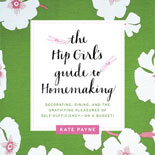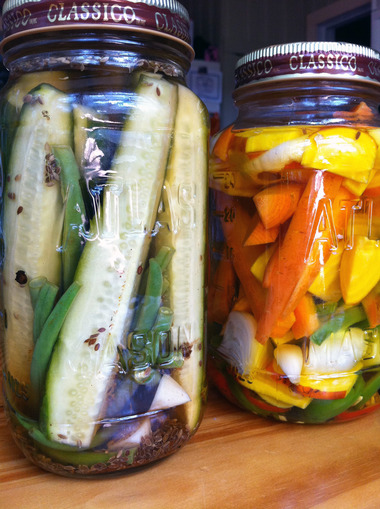Fridge pickles 101
Many of you have met me in real life as a result of my pickle evangelism. Now, I have to tell you a little bit about this. I’m a pickle fan, yes, but pickle evangelical? I’ll qualify that by saying how my relationship with my refrigerator has been a long and rocky road. Learning that I could modify any waterbath canning recipe, not only making it smaller, but switching up the vinegar, adding or subbing other kinds of veggies and other off-the-cuff experimentation, all via fridge pickling changed my life.
I’ve gone across the country on the first half of my book tour showing folks how to use up those veggies (before they compost in the crisper drawer). Homemade pickles make great snacks for parties, items to trade at food swaps, or even bestow upon (local) friends as holiday gifts.
Fridge pickles are a type of fresh pickle, but they’re stored in the fridge and not waterbath canned for shelf-storage. The other major branch of pickling involves fermenting (also called brining). Fermented pickles are usually stored in the fridge after they’ve reached the desired level of sourness at a cool-ish room temp of 70-ish degrees F. (Think LES full-sour versus a half-sour. They’re the same pickle, but one is fermented longer.)
Have I lost you already? Don’t worry, there will be no final exam on pickling methods and terminology. The only thing you will be required to do is try a batch of refrigerator pickles.
Here’s the formula for making roughly one quart or two pints of fridge pickles:
1. Wash and cut up your vegetables and pack them into a clean jar. Use whatever veg you’ll eat (or put into a martini): cucumbers, broccoli, cauliflower, Brussels sprouts, carrots, onions, garlic, etc. Weight of your starting produce will vary depending on what you’re pickling. Eyeball it at the market, and if you end up with too little veg, just use a smaller jar (or make more brine to account for extra space in the jar).
It’s up to your palate how to prepare the veggies. I’m a fan of the raw pack (putting the veg in the jar raw), but if you like a more tender, cooked texture, then you can blanch the veggies and/or cook them in the brine (step 3) for a bit to soften them up.
2. Add spices, fresh or dried directly to the jar. For a quart jar, use anywhere between 1/4 and 1/2 tsp of whole dried spices like peppercorns, fennel, cumin, coriander, dill, cloves, or whatever sounds delicious to you.
3. Combine in a medium saucepan and bring to a boil:
- 1 cup any kind of vinegar
- 1 cup filtered water
- 1 Tbs of Kosher or any non-iodized salt
You can add sugar if you like a sweet pickle, but the above is a standard tart pickle recipe. Try starting with 1 tsp sugar; be sure to taste the brine to see if you like it.
4. Pour your just-boiled brine over the vegetables in the jar.
5. Wipe any vinegar spills from the rim with a clean towel or a paper towel and put on the lid. Any lid is fine here since you’re not shelf-sealing the jar, reuse your already used two-piece lids or recycle those single-piece screw lids that once capped salsa, tomato sauce or peanut butter.
6. Now for the hard part. Hide the jar in the back of the fridge for at least a week. Two weeks is better, and three weeks is best. Your pickles will only continue to become more deliciously infused. But if you break into them early, I won’t tell. They’ll keep what seems like forever, but if you have pickle experiments in there from more than 6 months back it’s probably time to do a fridge inventory.
Tips to remember for fridge pickling:
- A regular-mouth jar will be better for pickling since it will help prevent your veggies from all floating to the top once you pour over the brine. Some may still float, but the constriction (vs. the straight-sided wide-mouth jar) is helpful.
- Don’t screw on the lid on as tightly as you possibly can or the lid might pop off when you go to open them in a couple weeks. Vinegar breaking down the veggies inside a jar causes a little release of gas, and leaving the lid loose will let that escape. [I know what you’re wondering and the answer is no. If your pickles have been stored in the fridge, it’s not possible for botulism spores to activate.]
- If you become a pickle evangelical, too, grab some of these plastic lids so your re-usable bands don’t rust.
- Fridge pickling is a one-way equation. Any waterbath canning recipe can be turned into a fridge pickle, but any fridge pickle may NOT be turned into a waterbath-safe recipe.
- My pickle bible is Linda Ziedrich’s The Joy of Pickling; I defer to her excellent flavor ideas when I have a pile of vegetables at my disposal.
- Check out page 230 in my book for a quick and easy just-like-Lower-East-Side dill pickled cucumbers recipe!
Check out these fun recipes from friends:
Marisa’s Asian-Inspired Refrigerator Pickles
Tigress’ White Radish Pickle
Audra’s Pickled Onions for Cocktails





 Tuesday, May 31, 2011 at 7:13AM
Tuesday, May 31, 2011 at 7:13AM

Reader Comments (29)
I just made some pickled radishes over the weekend. Still waiting to taste the results. We, too are pickle fanatics - they never last long in this house and we make lots of them!
Glad to hear you like the plastic bands - I've been thinking of investing and phasing out the metal.
Oh! Those beets look luscious.
I'm excited for zucchini season so that I can once again make the marvelous Zuni Cafe pickle (http://www.thewednesdaychef.com/the_wednesday_chef/2008/08/zuni-cafes-zucc.html)!
This is SO cool. I love that you've used other veggies besides cucumbers. What a fun experiment. I bet you could make spicy or sweet, or all th eabove. Mind. Blown.
So yummy! I am growing a bunch of walla walla onions just so I can pickle them. So tasty!
Yum! Might be trying this sometime this summer... my grandma used to make these yummy fridge pickles... her cukes were good, but the real surprise were the zucchini. Good stuff!
Oh hooray!! Thanks for sharing this! What on earth could be easier? I'm planning on getting a canner later this summer, but I can get a head start by doing this, not to mention use up the extra veggies from my weekly CSA box. Awesome!
Amen, sister! You are preaching to the choir on this one. I love me a good fresh pickle. So easy! And so beautiful, I might add. And you lay it out so clearly! I think you just saved many a CSA veggie.
I recently pickled some chunks of watermelon rind with my basic fridge pickle brine along with a pile of dill seeds and garlic. They're fantastic! Fridge pickles are indeed a wonder!
Psst .. you're gonna post this to Punk Domestics, right? RIGHT? :)
Thank you thank you thank you. I've been looking for this.
We are on it! Why isn't everything this simple?
Working on our sauerkraut technique right now as well. Thank you for sharing!
Oh my gosh! I just posted a discussion on the FB page for this exact thing! I guess I should probably come here first from now on huh? LOL I am SO excited to try this today! I have a bunch of zucchini and a few actual pickles to use up! I guess I'll let you know how they turn out in about three weeks! ;)
I followed your formula here but my pickles were kind of... flat and boring tasting. I used some late-season Kirby cukes that were pretty big and seedy; do think that's what went wrong?
Kristen, It might depend on a few things. If the cukes were big and seedy (and bland at the start), that could certainly affect final flavor. Vinegar, water and salt certainly don't improve a bland veg into a zesty one. Also, spice freshness might also come into play.
You mentioned in your blog post that your first batch went great. What did you do differently? This method here isn't a quick pickle, like many fridge recipes you might find floating around out there. So, even two weeks is perhaps not enough time for the vinegar to work its magic, try them in another week or two and see if that changes the flavor any more.
I'm a brand-new pickler, and I just used this to make:
1.) Spicy green beans
2.) Spicy giardinera mix (carrots, cauliflower, celery, romanesco, and spicy birds-eye chilies)
3.) Dill cukes.
This was so easy... I can't wait to see how they turn out! Thank you!
Thank you so much!!! This answered ALL of my questions!!!
I have a question.....we used canning jars and they sealedafter pouring the brine on .....do we need to throw them out bcs botulism thrives in anaerobic conditions?
I am hooked on making refrigerator pickles now! Love it! The only change I made was I found that this recipe has a bit too much vinegar for my taste so I cut it down to 2/3 cup.
I made these a couple of times and they are great. I used mustard seeds, coriander seeds, fennel seeds and dried dill. I also used a mixture of apple cider, balsamic and white vinegars
I found them to be tasty after just a few hours in the fridge, but they do mellow out after a couple of weeks. Yum.
Oh my. I might've just fallen in love. I've always wanted to pickle things, but I've had this strange notion that it's a difficult thing to do, and therefore just haven't made the time to try it... I s'pose it's rather like making good pie in that sense!
Anyways, thank you for sharing :] I'll give them a go as soon as I've got time to!
I love to find people talking about pickling and canning.
I have several recipes on our blog that are canned goods - even a post on fridge pickles. Our recipe is slightly different - added a little of this and that - but I remember my first fridge pickle was the basic recipe as you have here.
Today I posted a great recipe for honey strawberry vanilla jam. Come and take look http://sistersplayinghouse.blogspot.com/2012/10/homemade-pantry-day-25-honey-strawberry.html
Great article. This was exactly what I was looking for, the underlying backbone to all pickling not just a particular recipe. The quart size is perfect. Thank you.
John
I just attended your class at Faradays. Excellent.
I know you emphasized the vinegar portion being accurate but what if you have extra tomatoes? Is it really important to weigh and use only 1 lb-or whatever the recipe calls for- or is it ok to use more of your fruit or vegetable but keep the liquid ratio correct. ? I am talking small amounts more. Not 2 lbs vs 1 lbs.
Hey Vickie,
I just give the 1lb guideline here so that folks know how much veggies will approximately fit into a quart jar! No need to weigh at all, since when you can't fit any more in the jar, then you have your pickles! The vinegar ratio is only important when sealing the jars for shelf storage in a waterbath canner, with a recipe you're making and plan to keep in the refrigerator, you're welcome to tinker and adjust to taste! Let me know if you have any other questions. Happy pickling!